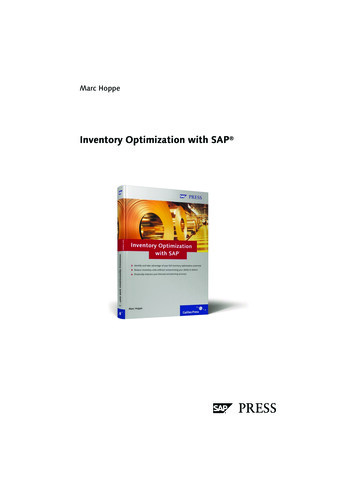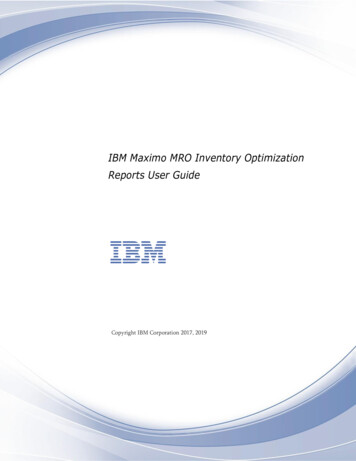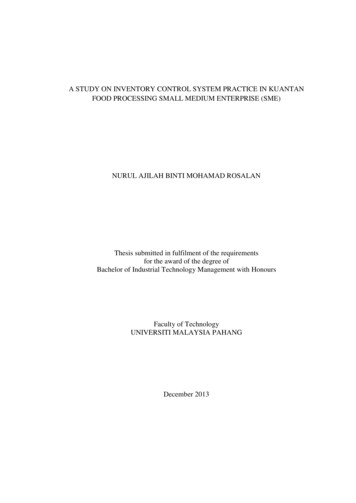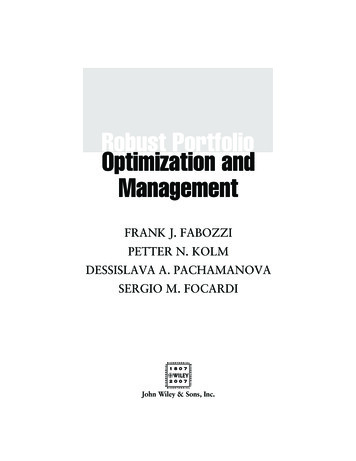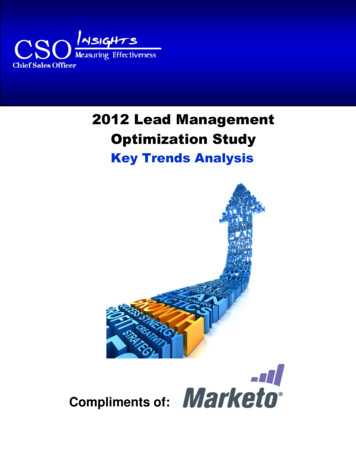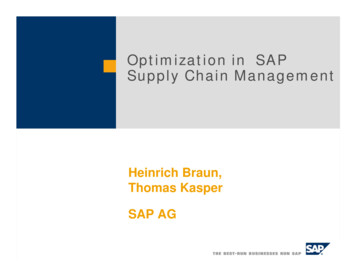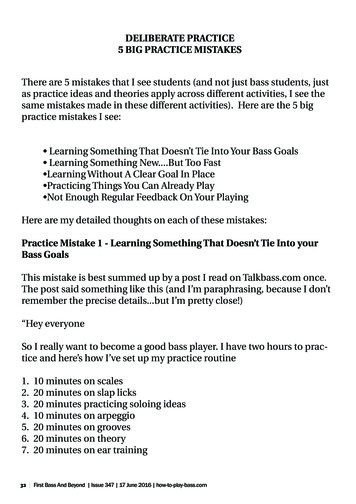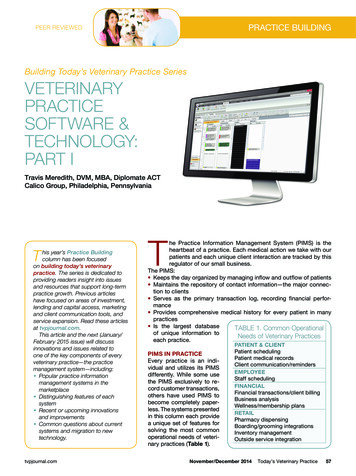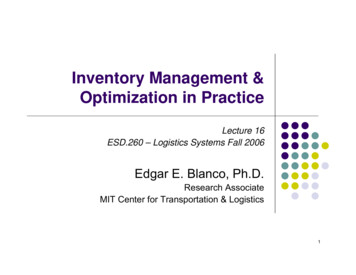
Transcription
Inventory Management &Optimization in PracticeLecture 16ESD.260 – Logistics Systems Fall 2006Edgar E. Blanco, Ph.D.Research AssociateMIT Center for Transportation & Logistics1
Session goalszzzzThe challenges of inventory management inpracticeApproachesThe supply chain dimensionRole of technologyMIT Center for Transportation & Logistics – ESD.260 Edgar E. Blanco, MIT2
Why do companies hold inventory inthe first place?zIt’s a buffer in the Supply ChainzzzzMain tradeoffzzzTime mismatch between supply-demandVariability (supply, demand, forecast error)Economic (costs, discounts)Service levelInventory costKeep it to a minimumMIT Center for Transportation & Logistics – ESD.260 Edgar E. Blanco, MIT3
The fundamental tradeoffInventory InvestmentTarget Service LevelsMIT Center for Transportation & Logistics – ESD.260 Edgar E. Blanco, MIT4
Three simple questions Three basic questions you want to answer throughinventory management:1. How often should I check my inventory?2. How do I know if I should order more?3. How much to order?MIT Center for Transportation & Logistics – ESD.260 Edgar E. Blanco, MIT5
What you have learned so far zNot all items are created equalzzVarious models with different assumptionszzzzzzzSegmentation is neededEOQ(s, Q)(s, S)(R, s, S)(R, S)Periodic vs. ContinuousDefinitions of service level mattersMIT Center for Transportation & Logistics – ESD.260 Edgar E. Blanco, MIT6
Reality check “More than 60% of companies use overly simplisticinventory management methods. These companiesfrequently have 15-30% more inventory than theyneed and lower service levels. By contrast,companies that reported using new optimizationmethods , commonly drove 20-30% reductions inon-hand inventory and 10-20% improvements intime to market.”Aberdeen Group, March 2005MIT Center for Transportation & Logistics – ESD.260 Edgar E. Blanco, MIT7
Good news & bad newszGood newszzzUnderstanding theoretical models is important and mattersYou can make money on this field!Bad newszzzModels are not used exactly as you have learned themTechnology mattersBusiness processes matter even moreMIT Center for Transportation & Logistics – ESD.260 Edgar E. Blanco, MIT8
Q1: How often?zHome Depot Retail*zzzzProcessing power may be the bottle neckzzzz1,800 stores40,000 – 50,000 different itemsApprox. 72-90 Million item/store combinationsSingle server example:z Single database can process 500 transactions per secondz 40-50 hours to “check” inventoryAnd you still need to do the math Distributed powerOther exampleszzzzDepartment Store – 200,000 itemsGrocery Store – 100,000 itemsBook Store – 150,000 itemsOnline Store – 5 million items* Source – Home Depot 2004 Annual ReportMIT Center for Transportation & Logistics – ESD.260 Edgar E. Blanco, MIT9
Q1: How often?zzSegmentationConstrained by technologyzzz(cont.)Fashion Retailers – Daily/WeeklyGrocery Retailers – Hourly / 3-4 times a dayConstrained by business processeszzzzWhen are sales reflected in your inventory?How often can you receive merchandise?How often do you get orders from your clients?Vary by time of the year?MIT Center for Transportation & Logistics – ESD.260 Edgar E. Blanco, MIT10
Q2: Should I order?zFunction of two variableszzzInventory PositionzzzzzInventory PositionOrder PointOn handOn orderCommittedBackordersOrder Point is a function of the inventory modelMIT Center for Transportation & Logistics – ESD.260 Edgar E. Blanco, MIT11
Inventory position:What can go wrong?zSource: from ERP/legacy systemszzOn handzzzzzzzDatabasesIncorrect product codes“Fat Finger”Scanner/Reader problemsMissing product codesShrinkageReturnsPhysical Inventory / ReconciliationMIT Center for Transportation & Logistics – ESD.260 Edgar E. Blanco, MIT12
Inventory position:What can go wrong?zWhen is something On-Order?zzzzzOrder has been generated by the systemOrder has been transmitted to the supplierOrder has been accepted by the supplierOrder has been shipped by the supplierUsually when an order has been generated by thesystem is added as an “on-order”zz(cont.)Includes an expected arrival dateExpected arrival date is importantzzzWill this expected arrival date get updated? By whom?How about partial orders?How about multiple vendors?MIT Center for Transportation & Logistics – ESD.260 Edgar E. Blanco, MIT13
Inventory position:What can go wrong?z(cont.)Backorders & CommittedzzCancellation policy“Phantom Orders”On-OrderTime“Grace Period”Order isplacedMIT Center for Transportation & Logistics – ESD.260 Edgar E. Blanco, MITOrder isFulfilled14
Q3: How much to order?zFunction of the inventory modelzzzSegmentation is widely used for selecting between inventorymodels or model parameterszzzOrder PointOrder QuantityABC analysis on volume/sales dollarsProblemsz Homogenous at the sub-class/item levelz Little thought around variabilityz Not revised frequently enoughTechnology – Automated ReplenishmentzzException basedAnalysis tools (limited)MIT Center for Transportation & Logistics – ESD.260 Edgar E. Blanco, MIT15
Which inventory models are used?zzWhich ones are supported by my vendor or legacy system?Vendor selection becomes crucialzzzzzzRetailzzzzzCost/ROIWhat is the problem I am trying to solve?How does it fit with my business process?Which inventory models are supported?Do I have the data?Two broad types of products:z Basics – longer lifecycles, mostly seasonalz Fashion – short lifecycle, always seasonal(R, s, S) – Also called min/maxVariations of (R, s, S) to accommodate seasonal demandVariations of (R, s, Q)z To accommodate seasonal demandz Life cycleManufacturingzzzAll types of approachesForecasting based“Supply Chain” basedMIT Center for Transportation & Logistics – ESD.260 Edgar E. Blanco, MIT16
Inventory models challenges AssumptionszNon - Stationary demandzzzzFinite CapacityzzzzForecastingRecalculate parameters on a regular basisz Manualz (R, s[t], S[t])z (R, s[t], Q[t])May help with life-cycleRough adjustmentsIndependent items-locationsNo crossing/split of ordersDemand size of oneMIT Center for Transportation & Logistics – ESD.260 Edgar E. Blanco, MIT17
Inventory models challenges Data: Garbage In, Garbage T Center for Transportation & Logistics – ESD.260 Edgar E. Blanco, MITSales &Operations18
Inventory models challenges Data: Garbage In, Garbage Out(cont.)Consider generic reorder point calculation:s XL R k * σL R Are forecasts accurate? Demand vs. Sales? Promotions? Who collects lead times? How often are they updated?z How was error estimated? Includes lead time variability? PDF assumed? Who defines/owns service levels? How often are they updated?Technology & business processes are the maindrivers to minimize the impactMIT Center for Transportation & Logistics – ESD.260 Edgar E. Blanco, MIT19
Inventory models challenges Consistently inaccurate datazzHolding & ordering costsService levelszzzzDefinitionFinancial impactService level targets at the item-location levelCapacityzPush vs. PullMIT Center for Transportation & Logistics – ESD.260 Edgar E. Blanco, MIT20
Beyond the item-locationzzInventory decisions are made at the item-locationlevel“Optimal” decisions at item-location may not be thebest decisions for the systemzzzzzEx: Service levelEx: Presentation stockEx: Substitute itemsEx: Vendor level managementEx: Multi-echelonMIT Center for Transportation & Logistics – ESD.260 Edgar E. Blanco, MIT21
Multi-echelon inventory managementSuppliersTier 3ManufacturingTier 2ManufacturingTier er 2SuppliersTier 1Manufacturing/Assembly OperationInventoryWhere should I keep the inventory?Material FlowDemand SignalMIT Center for Transportation & Logistics – ESD.260 Edgar E. Blanco, MIT22
The fundamental tradeoffBy looking at thewhole supply chain,you may be able tochange this trade-offInventory InvestmentTarget Service LevelsMIT Center for Transportation & Logistics – ESD.260 Edgar E. Blanco, MIT23
Multi-echelon inventory managementzIgnore itzzBullwhip effect - upstream levels of the supply chainobserve higher variability which translates into highersafety stock levelsTackle itzzzzIncrease complexityVisibility & data sharingAdvanced inventory modelsBusiness processes!!!!!MIT Center for Transportation & Logistics – ESD.260 Edgar E. Blanco, MIT24
Technology landscapezLegacy systemszzERP/SCP vendors provide inventory models in theirbase replenishment packageszzzzVarious degrees of sophisticationUsers have to configure parametersz Daunting taskz Support tools sold separatelyIntegration with forecasting (data level)Check the assumptions!Niche vendors connect to ERP systems to providetailored inventory management modelsMIT Center for Transportation & Logistics – ESD.260 Edgar E. Blanco, MIT25
Niche vendorsOracleManufacturingOptianti2Logic ToolsSmart OpsGAIN SystemsDistributionTools GroupInventory ConfigurationInventory PolicyFigure by MIT OCW.MIT Center for Transportation & Logistics – ESD.260 Edgar E. Blanco, MIT26
Questions?Edgar E. BlancoResearch Associate, MIT-CTLMIT Center for Transportation & Logistics – ESD.260 Edgar E. Blanco, MIT27
zHome Depot Retail* z1,800 stores z40,000 – 50,000 different items zApprox. 72-90 Million item/store combinations zProcessing power may be the bottle neck zSingle server example: zSingle database can process 500 transactions per second z40-50 hours to “check” inventory zAnd you still need to do the math zDistributed power zOther examples zDepartment Store – 200,000 items zGrocery .


